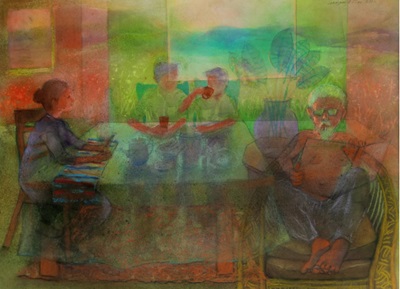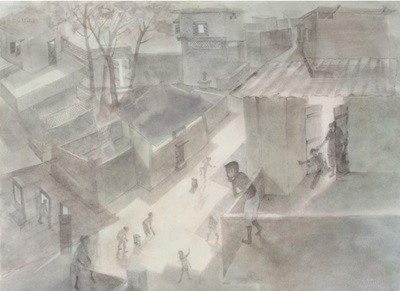
Written by: Nimra Khan
Posted on: May 10, 2024 |  | 中文
| 中文
Back To Nature - 8
Karachi-based artist Masood A. Khan presents his latest collection of paintings in a recent show at Sanat Gallery, “Listen to your Heart”, where he continues to negotiate his spiritual musings with socio-political, economic and ecological concerns emerging from current global affairs. This unfolds through a vocabulary of drawings from various influences and a visual style placed somewhere between Modernism and Realism. It has the subtle symbolism of one and responsive directness of the other, giving shape to a dichotomous narrative. In a world of hidden agendas, dual meanings, duplicity and exploitation, his language of overtness and transparency becomes a welcome respite.
Over a period of three decades, during which he worked in the banking sector and pursued his passion for painting simultaneously, Khan sensed a repetitiveness and lack of originality in his work, which compelled him to isolate himself from the art world and restrict all visual stimuli in order to begin a “journey of self-discovery and rejuvenation”, as he puts it, in order to dial down the visual noise in order to tune into his own inner voice and discover his own unique identity.
His work adopts a process of multiple translucent layers, washes upon washes of watercolor, acrylic, charcoal and ink creating an image that lays bare all its secrets. What results is an essence of truth, the “quintessence of naked reality”, our world presented as it might appear in the eyes of God, a world laid bare in all its glory. Khan muses that this need for openness, for an almost voyeuristic tendency to reveal every aspect of a scene, perhaps can be excavated from his own personal history of confinement. Hailing from Kushtiya, a small town in Bangladesh, the artist’s family was imprisoned in a concentration camp in Allahabad after the fall of Dhaka in 1971. Thus, Khan’s surfaces are explicit and direct.
However, these past experiences also seem to feed into the narrative, with its anti-war imagery, operating on multiple levels that feed into each other. Economic, socio-political and ecological concerns, each acting as a metaphor for the other, but all also interconnected. Serene landscapes in luminescent, pastel shades depicting everyday life are offset by anti-war rhetoric and political imagery, and while these may seem like contradictory narrative threads, they are more like two sides of the same coin.
A recurring theme in this current series seems to be the humanitarian crisis in Gaza, and Israel’s unrelenting attempts at ethnic cleansing, genocide and settler colonialism, which has set ablaze our socio-political landscape. Every horrible war-crime imaginable is unfolding right before our eyes, and the onslaught of horrific imagery of children crushed under rubble has become a daily reminder through our newsfeeds, yet the world turns a blind eye, and even in some cases sides with the perpetrators of violence, dehumanizing the victims.
Works like Confusion and Listen to your Heart urges us to seek the truth within this cacophony of propaganda brought to us through our screens. Even as all religions stand equal, they are used to divide us and to oppress and subjugate, blinding us to the truth through the media and social media machinery. Thus, it becomes a critique of modern times where social media rules our lives and conflicting news from various sources clouds our judgement further. Religions, faiths and beliefs are pitted against each other in a bid for more views and global conflicts are propagated rather than resolved. Guernica Reviewed, is another work that critiques the Zionist ideology of the “promised land” being used to inflict violence and death, through a reworking of Pablo Picasso’s famous “Guernica” (1937), an anti-war artwork.
In some of the works, this idea seems to be presented in a more oblique fashion, through dual interpretation and metaphor, with the allegorical use of animals driving the narrative. These works have a more distinct approach to style, executed in acrylic paint and grout on board with a thick application of bold and deep colors and rough textures, resulting in a more static, opaque feel rather than the open, loose, and transparent worlds seen in most of the works.
Khufia Haath (Mysterious Forces), for instance shows a tree full of squirrels rendered almost in relief form being chopped by a mysterious figure, which can be taken for its literally ecological message, but also depicts the current situation in Palestine where an entire population is being wiped out, their homes decimated. Both readings are also valid at the same time, as war and genocide itself is an ecological disaster. Messiah is another work that shows a bull piercing a huge crocodile with its horns to save a group of lambs standing in the distance, which again is a depiction of the triumph of good over evil. Here, the bull is painted red with a black snout, horns and hooves, alluding to the Red Heifers rejected for their black markings, ultimately becoming the salvation of the innocents.
These works are offset by the simpler scenes of mundane life and banal rural scenery, which seem to be in contrast to the more overtly political statements. Yet, their politics is in their subtlety. Back to Nature along with works like Ek Thandi Raat (One Cool Night), Jharoo Wali Amma (The Old Woman with a Broom) and Morning of a Normal Workday, depict joyful scenes executed in soft, watery layers of transparent paint, and are the artist’s way of positing a return to a simple and a more sustainable way of life, away from modern perils. Breakfast and Mehfooz Chai similarly show mundane scenes and activities. These works are executed in a Modernist style with the color palette seen in the works of Colin David and Moeen Faruqi, with themes closer to that of Realism.
Yet, at the same time it seems like a form of escapism. It tugs at our sense of survivor’s guilt, even as we go about our everyday lives and celebrate our little achievements, milestones and life events even when the world is on fire. It reflects our incongruent newsfeed, showing mangled dead bodies in one instant and smiling laughing faces in another, followed by pretty clothes and celebrity gossip. It becomes a reminder of the fact that no matter how many children are killed, life goes on as is and the world moves on, finding a way to justify it and in the process revealing its hypocrisy.
The subject matter seems to range from banal scenes from nature and rural life to socio-political, economic and environmental commentary, or perhaps both things are connected, with the scenes from mundane everyday life also making broader socio-political statements.

Ek Thandi Raat

Breakfast

Jharoo Wali Amma

Haazri
You may also like: